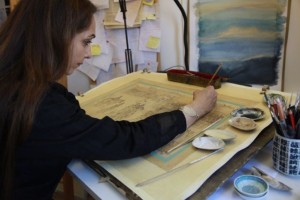Dr. Veeda Ahmed
Trained initially as a painter and sculptor, she did her MFA from the Department of Fine Arts, University of the Punjab, in Lahore, with a First Class First position and a Gold Medal. She then went on to study at the Ruskin School of Drawing and Fine Art, University of Oxford. Upon her return to Pakistan she exhibited in numerous group shows before moving to London in 1990 where she is presently based. She held her first solo exhibition at the Barbican in 1994 and another solo at the Chawkandi Gallery in Karachi in 2000. She joined The Prince’s School of Traditional Art, London and completed her Doctorate this year (in 2013), the title of her practice based PhD being “Drawing on Tradition: The recognition and relevance of the elements of Persian, Mughal and Pahari drawing and painting in the contemporary art practice of Indo-Pakistan.”
She is a member of the Chelsea Art Society, London and The Islamic Manuscript Association (TIMA) in Cambridge.
Her PhD research centred on the Persian, Mughal and Pahari drawings and paintings, an important heritage of her country of birth, Pakistan. The study focussed on neem rang and siyah qalam drawings and paintings, the purpose here was to perfect the methods and materials used in this ancient craft, master the drawing skills and achieve a deeper understanding of the underlying compositional geometry used in these paintings and also the colour symbolism behind the craft in question.
In the past there was a huge element of secrecy surrounding the art of miniature painting, with its valuable knowledge being passed down from the ustad (teacher) to his shagird (pupil). Sadly there is no technical treatise written by an artist is available today, and the craftsmen are using inferior materials in their craft. Before all the technical knowledge is lost, it is important to document and preserve what can be retrieved of this ancient art form from all available sources.
Her paintings, exhibit a blend of her traditional Indo-Pakistani roots and her strong Western training. There is a subtle hint of the above elements coming together, the mingling of the two cultures one from the East and the other the West; when one is stronger or in the foreground the other is pushed into the background. The paintings on view show a process of exploring, searching, and synthesizing, to capture the spirituality of a subject or thought. In most of her paintings colour is applied and washed off till the energy of a form starts to evolve. Through folding or unfolding, formation or transformation, placing of layers of colours and washing them off and finally drawing with a very fine squirrel hairbrush until a semblance of a form appears whilst another disappears. This work thus points to a new direction, although it is deeply rooted in her indigenous background but is not rigidly constrained by replicating the old traditional form. Drawing from the repetitiveness of the patterns of Islamic art, and the perfect pardakht (shading) using nuqtas (dots) and lakeerain (lines) of the old miniatures. Using these simply as a guideline to produce an art that is thought provoking, meditative, mystical, thereby stimulating the spirit of the past in the present. Practising and incorporating important traditional methods and materials of a dying craft, is a perfect way of keeping the old tradition alive today.
Hopefully her paintings will continue to evolve, as she wants to search, research and practice exploring further the realm of the spiritual and mystical, employing the finest materials and pigments, thus trying to keep the thread of the skills, methods and materials of the past alive, using this as a point of departure into an unknown realm. Lets see what unfolds.
